An empowerment driven approach is one of the fundamental edicts of IEC’s work in contrast to an input driven approach.

The very design of the learning and governance approach is based on “ourness” and not “otherness”. This applies to all stakeholders that IEC works with: parents, communities, teachers, and the department functionaries.
Therefore, across all the interventions, the focus is to strengthen the existing structures and the leadership abilities of the stakeholders to take forward the approach, ensuring sustainable change.
This is initiated from the beginning of the implementation itself. This ensures that the program is sustained by the efforts of the stakeholders themselves such as Teachers, Cluster Resource Coordinators, District Institute of Education and Training, School Management Committees and Panchayat bodies.
District Institute of Education & Training
- Provide leadership guidance to CRC’s through monthly planning meetings.
- Monitor the quality of meetings and outcomes
School Complex Head/ Cluster Resource Coordinator
- Facilitate monthly academic meetings
- Provide on-field support to teachers in classrooms
Teacher Led Professional Learning Communities
- Collaborative learning amongst teachers
- Focus on reflection and planning for the classroom activities
- Increases motivation through peer support

In the learning approach, the structures of Cluster/School Complex and the District Institute of Education and Training (DIET) are critical for the teacher led professional learning communities to grow and sustain themselves.
The enterprise largely requires the enrolment of the government and key stakeholders into the vision and the conduciveness of the system to make this work. It is a lean and cost effective approach.
For the Governance Approach, the team in a district on an average, comprises of 8-9 people who would take responsibility for a block or two blocks depending on the geographical size of the district and the block.
Since the approach is more empowerment and less input driven, the idea is to work closely and strengthen the primary stakeholders. Therefore, the working strategy is to plan in such a manner that the team member functions more as facilitator to build the institutional capability of the structures.
This enables IEC to bring down the costs and ensure sustainability through stakeholder ownership of change in education.
Support transformation of a district
- To strengthen Panchayati Raj Institutions to take ownership of public education.
- To enable a community to build a vision for education of all children
Support transformation of a cluster
- To change the narrative of education from rote memorization to the development of foundational abilities to learn.
- To empower teachers to support the learning needs of every student in their classroom.
